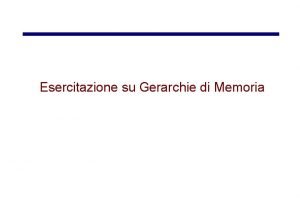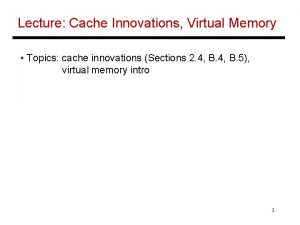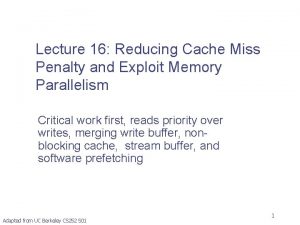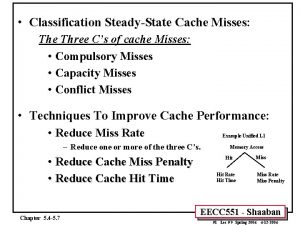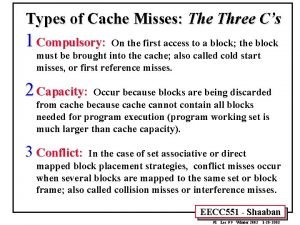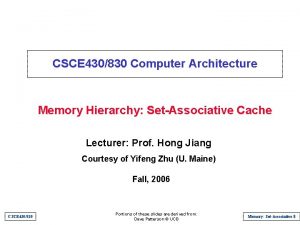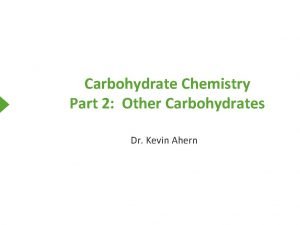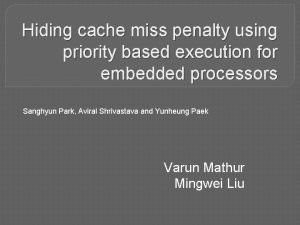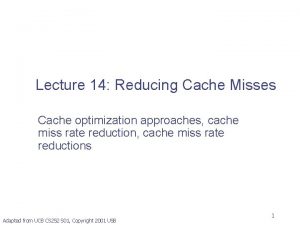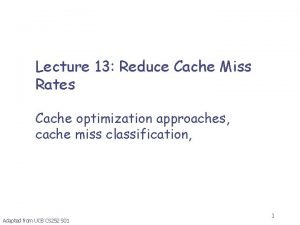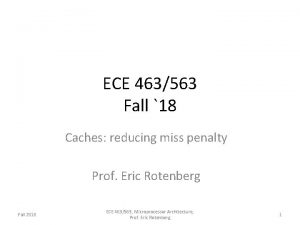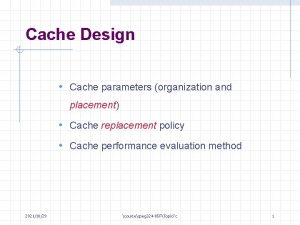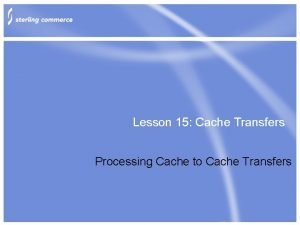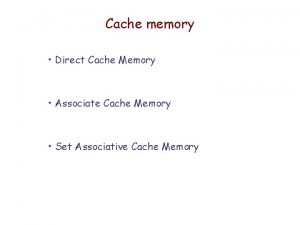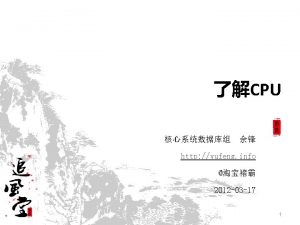Lecture 16 Reducing Cache Miss Penalty and Exploit














- Slides: 14

Lecture 16: Reducing Cache Miss Penalty and Exploit Memory Parallelism Critical work first, reads priority over writes, merging write buffer, nonblocking cache, stream buffer, and software prefetching Adapted from UC Berkeley CS 252 S 01 1

Improving Cache Performance 1. Reducing miss rates n n n Larger block size larger cache size higher associativity victim caches way prediction and Pseudoassociativity compiler optimization 2. Reducing miss penalty n n Multilevel caches critical word first read miss first merging write buffers 3. Reducing miss penalty or miss rates via parallelism Reduce miss penalty or miss rate by parallelism Non-blocking caches Hardware prefetching Compiler prefetching 4. Reducing cache hit time n n Small and simple caches Avoiding address translation Pipelined cache access Trace caches 2

Early Restart and Critical Word First Don’t wait for full block to be loaded before restarting CPU n n Early restart—As soon as the requested word of the block arrives, send it to the CPU and let the CPU continue execution Critical Word First—Request the missed word first from memory and send it to the CPU as soon as it arrives; let the CPU continue execution while filling the rest of the words in the block. Also called wrapped fetch and requested word first Generally useful only in large blocks (relative to bandwidth) Good spatial locality may reduce the benefits of early restart, as the next sequential word may be needed anyway block 3

Read Priority over Write on Miss Write-through with write buffers offer RAW conflicts with main memory reads on cache misses n n n If simply wait for write buffer to empty, might increase read miss penalty (old MIPS 1000 by 50% ) Check write buffer contents before read; if no conflicts, let the memory access continue Usually used with no-write allocate and a write buffer Write-back also want buffer to hold misplaced blocks n n n Read miss replacing dirty block Normal: Write dirty block to memory, and then do the read Instead copy the dirty block to a write buffer, then do the read, and then do the write CPU stall less since restarts as soon as do read Usually used with write allocate and a writeback buffer 4

Read Priority over Write on Miss CPU in out Write Buffer write buffer DRAM (or lower mem) 5

Merging Write Buffer Write merging: new written data into an existing block are merged Reduce stall for write (writeback) buffer being full Improve memory efficiency 6

Reducing Miss Penalty Summary Four techniques Multi-level cache n Early Restart and Critical Word First on miss n Read priority over write n Merging write buffer n Can be applied recursively to Multilevel Caches Danger is that time to DRAM will grow with multiple levels in between n First attempts at L 2 caches can make things worse, since increased worst case is worse n 7

Improving Cache Performance 1. Reducing miss rates n n n Larger block size larger cache size higher associativity victim caches way prediction and Pseudoassociativity compiler optimization 2. Reducing miss penalty n n Multilevel caches critical word first read miss first merging write buffers 3. Reducing miss penalty or miss rates via parallelism Reduce miss penalty or miss rate by parallelism Non-blocking caches Hardware prefetching Compiler prefetching 4. Reducing cache hit time n n Small and simple caches Avoiding address translation Pipelined cache access Trace caches 8

Non-blocking Caches to reduce stalls on misses Non-blocking cache or lockup-free cache allow data cache to continue to supply cache hits during a miss n Usually works with out-of-order execution “hit under miss” reduces the effective miss penalty by allowing one cache miss; processor keeps running until another miss happens n n Sequential memory access is enough Relative simplementation “hit under multiple miss” or “miss under miss” may further lower the effective miss penalty by overlapping multiple misses n Implies memories support concurrency (parallel or pipelined) Significantly increases the complexity of the cache controller Requires muliple memory banks (otherwise cannot support) n Penium Pro allows 4 outstanding memory misses n n 9

Value of Hit Under Miss for SPEC 0 ->1 1 ->2 2 ->64 Base “Hit under n Misses” Integer Floating Point FP programs on average: AMAT= 0. 68 -> 0. 52 -> 0. 34 -> 0. 26 Int programs on average: AMAT= 0. 24 -> 0. 20 -> 0. 19 8 KB Data Cache, Direct Mapped, 32 B block, 16 cycle miss 10

Reducing Misses by Hardware Prefetching of Instructions & Data E. g. , Instruction Prefetching n n n Alpha 21064 fetches 2 blocks on a miss Extra block placed in “stream buffer” On miss check stream buffer Works with data blocks too: n n Jouppi [1990] 1 data stream buffer got 25% misses from 4 KB cache; 4 streams got 43% Palacharla & Kessler [1994] for scientific programs for 8 streams got 50% to 70% of misses from 2 64 KB, 4 -way set associative caches Prefetching relies on having extra memory bandwidth that can be used without penalty 11

Stream Buffer Diagram from processor to processor Tags head tail tag and comp tag tag Direct mapped cache Data a a one one cache block +1 next level of cache of of data Stream buffer Source: Jouppi ICS’ 90 Shown with a single stream buffer (way); multiple ways and filter may 12 be used

Victim Buffer Diagram to proc from proc Tags Direct mapped cache Data next level of cache tag tag and and comp one one cache block of of data Proposed in the same paper: Jouppi ICS’ 90 Victim cache, fully associative 13

Reducing Misses by Software Prefetching Data Prefetch n n n Load data into register (HP PA-RISC loads) Cache Prefetch: load into cache (MIPS IV, Power. PC, SPARC v. 9) Special prefetching instructions cannot cause faults; a form of speculative execution Prefetching comes in two flavors: n n Binding prefetch: Requests load directly into register. w Must be correct address and register! Non-Binding prefetch: Load into cache. w Can be incorrect. Frees HW/SW to guess! Issuing Prefetch Instructions takes time n n Is cost of prefetch issues < savings in reduced misses? Higher superscalar reduces difficulty of issue bandwidth 14
 Miss penalty della cache
Miss penalty della cache Phosphorylase vs kinase
Phosphorylase vs kinase Maltosazone shape
Maltosazone shape Reducing sugar and non reducing sugar
Reducing sugar and non reducing sugar Techniques for reducing cache misses
Techniques for reducing cache misses Techniques for reducing cache misses
Techniques for reducing cache misses Techniques for reducing cache misses
Techniques for reducing cache misses 3 c's of cache misses
3 c's of cache misses How to calculate cache miss rate
How to calculate cache miss rate Reducing vs non reducing sugar
Reducing vs non reducing sugar 01:640:244 lecture notes - lecture 15: plat, idah, farad
01:640:244 lecture notes - lecture 15: plat, idah, farad Deontology death penalty
Deontology death penalty Echr death penalty
Echr death penalty Death penalty philosophy
Death penalty philosophy Affine gap penalty formula
Affine gap penalty formula
